🌄 Scroll I: The Map of Time and Sacrifice Sacred Time, Calendars of Stone, and the Cosmic Architecture of Death
⚠️ Cultural Complexity Disclaimer
Mesoamerican cosmologies — including Maya, Mexica (Aztec), Zapotec, and others — were diverse, multi-layered, and evolved across centuries. This scroll draws from widely attested themes in Nahua and Maya traditions, but does not claim to represent all Indigenous views. It weaves a symbolic thread through the Spiral of Time, sacrifice, and soul-journey as understood through sacred calendars, codices, and oral histories. This is one version of the truth — not the whole Codex.
🔥 Chapter 1: Time Is a Serpent, Not a Line
“Do not fear death. For the sun dies every night, and is born again with the dawn.”
Mesoamerican Proverb
The modern world sees time as a straight line. Climax. Decline. Death. A story with one direction and an end.
But to the ancient Mesoamerican mind, time was a serpent. Spiralling. Turning. Returning. Not a line, but a cycle.
Each day, the sun died and was reborn. Each season mirrored the blood of the maize. Each generation was a turning of the age, not a departure from it.
They built their calendars not with paper, but with stone. The Tzolk’in (260-day sacred count) governed ritual and destiny. The Haab (365-day solar year) tracked the world’s agricultural breath. And the Long Count reached across ages, marking the births and deaths of entire worlds.
These were not just calendars. They were codes. Keys to ritual timing. Astrological portals. And beneath them pulsed the truth: time was sacred. And it could be aligned.
At the great pyramid of Kukulcán in Chichén Itzá, the truth was written in light. Each equinox, a serpent-shaped shadow slithered down the steps, the body of Quetzalcoatl returning to earth. Not metaphor, precision.
To be human in this world was to be a participant in cosmic rhythm. Death was not exile. It was timed transition.
And when your time came, the path you walked in the afterlife would reflect not your morality, but the rhythm you lived within.
⚡ TL;DR:
- Mesoamerican time moves in cycles, not straight lines
- The serpent represents divine time spiralling through worlds
- Calendars are sacred instruments, not tools of control
- Birth and death are not random — they follow sacred rhythm
- To forget the cycle is to drift from cosmic truth
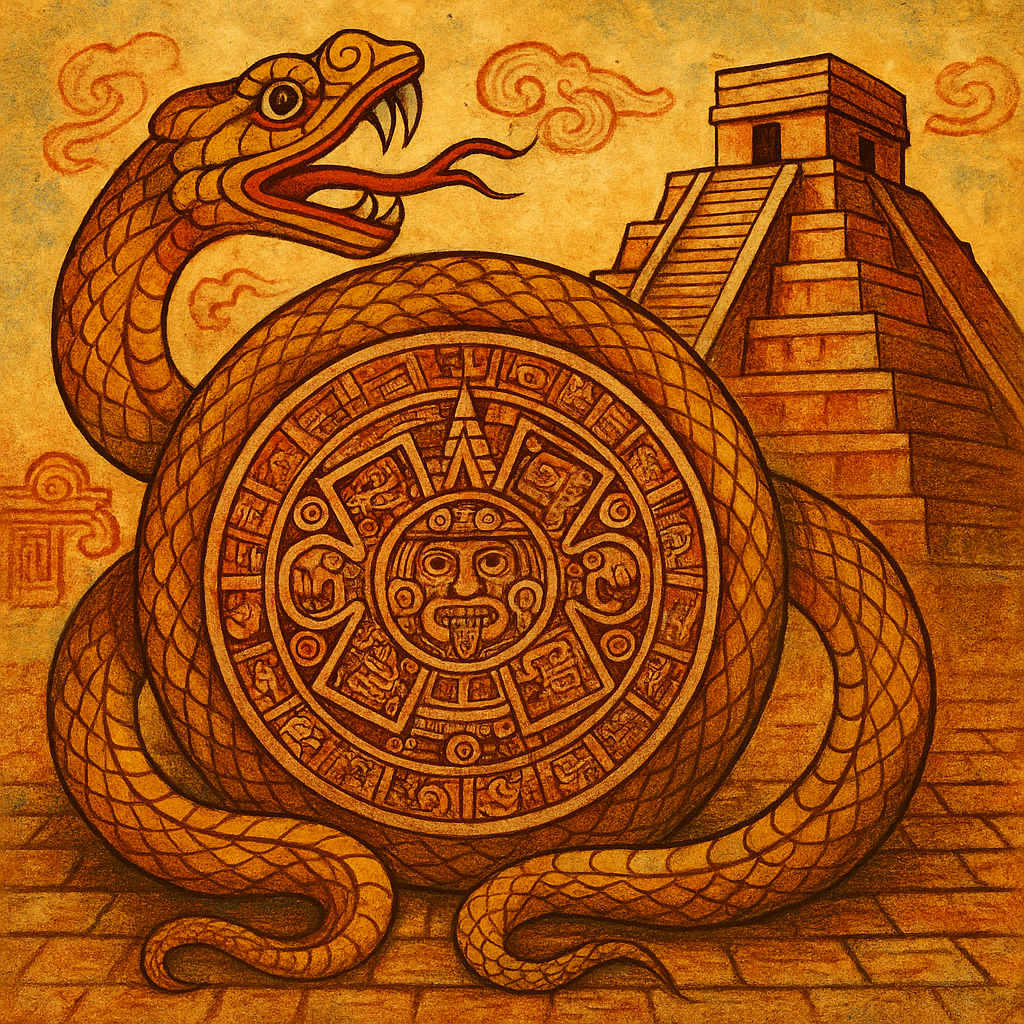
🔢 Chapter 2: The Calendar Round and the Turning of Worlds
Time in Mesoamerica was not counted to control, but to align.
The Maya understood that each human life, each eclipse, each act of sacrifice moved inside a nested rhythm, sacred numbers rotating through the sky and the soul.
The Haab — the 365-day solar year — governed seasons and the body. It contained 18 months of 20 days, plus five “nameless” days at year’s end, when the veil between worlds thinned. These were the Uayeb, dangerous, liminal, powerful.
Together, the Tzolk’in and Haab formed the Calendar Round, a 52-year cycle in which each combination repeated only once. Fifty-two years was more than a measure of age. It was a life spiral, a journey of remembrance, an initiation of return.
When the two calendars realigned, it marked a cosmic rebirth. Cities fell silent. Fires were extinguished. The people waited. Then, with ritual precision, a new flame was lit. A new cycle began.
This wasn’t superstition. It was metaphysical engineering. To misalign with the calendar was to invite disorder. To sacrifice at the wrong time was to sever the link between earth and star.
The turning of worlds wasn’t metaphor. It was literal — and lived.
And when that grand cycle turned in 2012, the world did not end. It restarted. As it always had. As it always would.
⚡ TL;DR:
- Tzolk’in (260 days) and Haab (365 days) interlock to shape sacred time
- The 52-year Calendar Round is a full cosmic breath
- Each person is born with a unique energy signature
- Rituals align human acts with celestial rhythms
- When the calendar resets, time is reborn — not ended
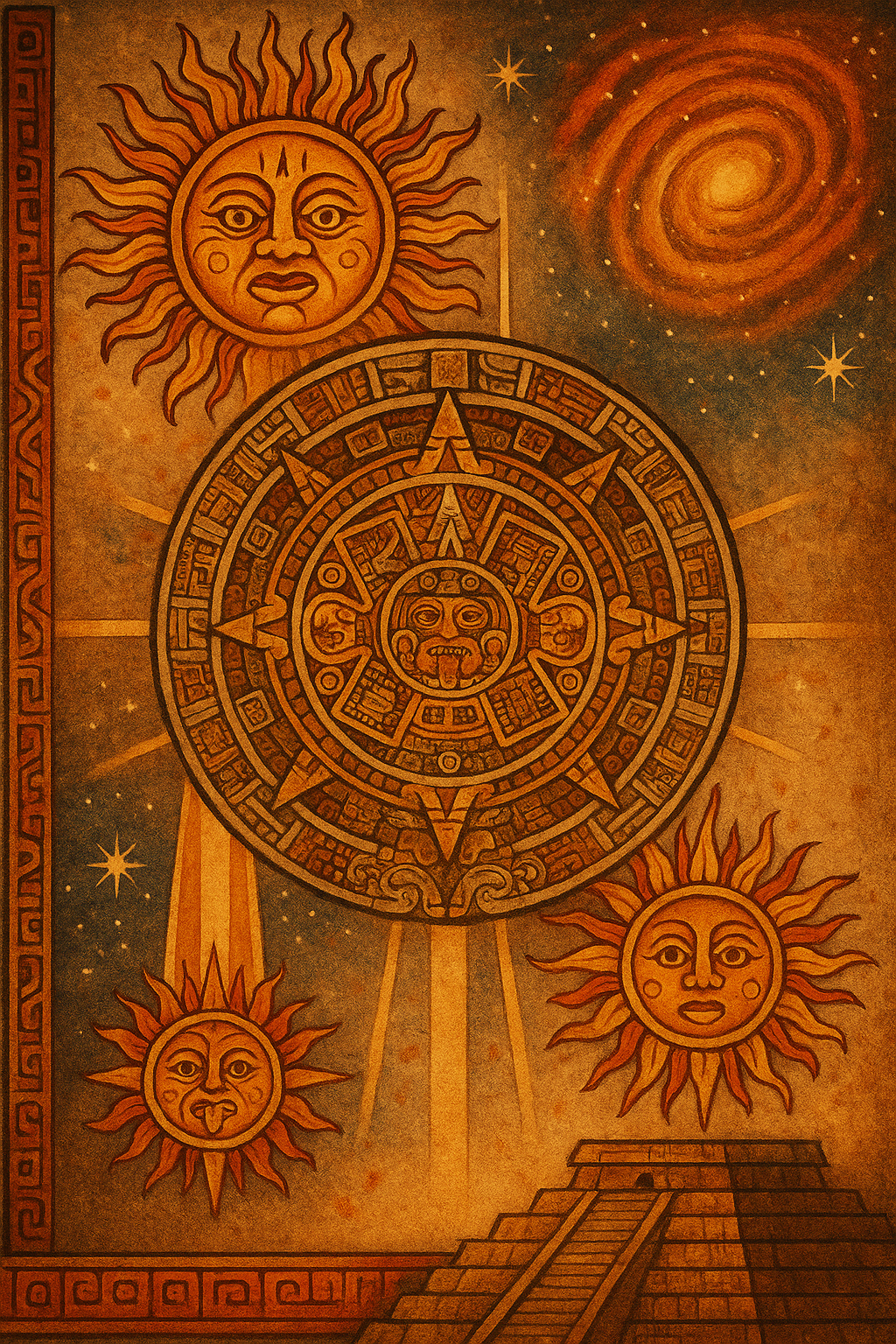
🐍 Chapter 3: El Castillo and the Serpent of Light
At Chichén Itzá, a temple waits for the sun to speak.
El Castillo, also known as the Temple of Kukulcán, is no ordinary pyramid. It is a calendrical engine — a stone resonance chamber built to synchronise heaven and earth.
It has four staircases of 91 steps each. Add the top platform: 365. The full cycle of the Haab. A solar year in stone.
But the miracle is not in the numbers. It is in the shadow.
Twice a year — during the spring and autumn equinox — the setting sun casts a serpent-shaped shadow down the northern staircase.
The body of Kukulcán, the feathered serpent deity, appears in motion. Light becomes myth. Stone becomes time. And the divine returns.
This wasn’t entertainment. It was ritual precision.
The people would gather to witness the descent. Not to worship. But to remember. That time moves in cycles. That gods descend and ascend. That the world is never static.
Every pyramid in Mesoamerica echoed this logic. The nine tiers of El Castillo mirrored the nine levels of the underworld. To climb upward was to symbolically pass through death, one level at a time. To descend, as the serpent did, was to bring divine essence back to the world.
In this worldview, architecture was not for shelter. It was for alignment.
Each pyramid was a mirror, of the heavens, the underworld, the human body, the calendar, and the soul. To walk its steps was to walk the path of return.
⚡ TL;DR:
- El Castillo is a solar pyramid designed for cosmic alignment
- During equinox, a serpent-shadow slithers down the staircase
- Architecture reveals the movement of gods and time
- Each step echoes the underworld and heavens
- To climb it is to enact the soul’s journey of return
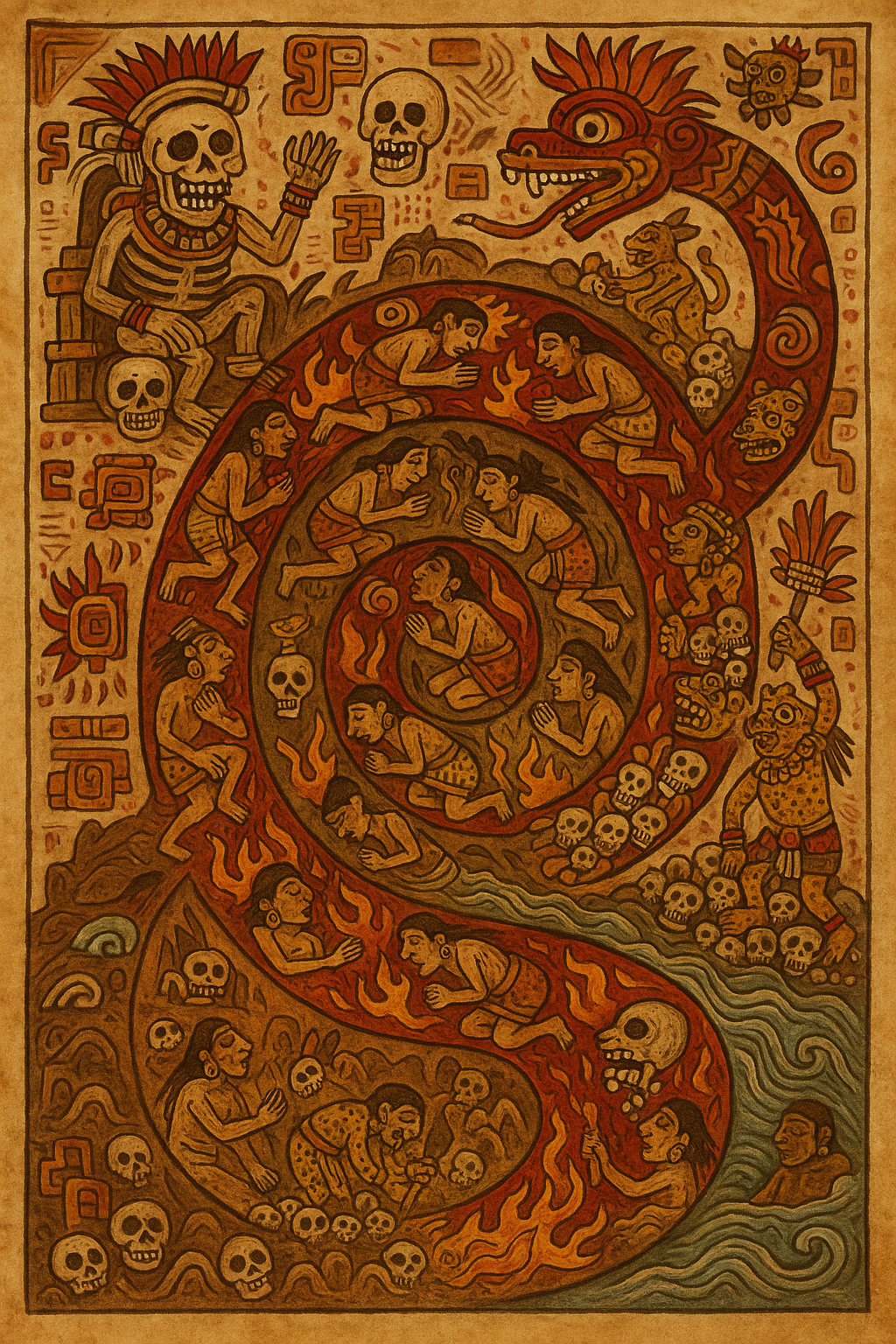
🔢 Chapter 4: Sacred Numbers and the Breath of the Cosmos
To the ancients of Mesoamerica, numbers were not neutral. They were alive.
Every sacred act, every direction, every breath of the gods followed numeric law. Not imposed — revealed.
At the heart of it all were two divine forces: Thirteen and Four.
Thirteen was the celestial principle, the number of heavens, the cycles of the gods, the levels of the upper world.
Four was the earthly cross, the cardinal directions, the corners of the world, the roots of the World Tree.
Together, they formed the sacred number 52, the span of a Calendar Round, the full rotation of the Tzolk’in and Haab. A human lifetime. A spiritual orbit.
When the number 52 completed its cycle, all fires were extinguished. People waited in silence. Would the gods return? Would the sun rise?
It always did. Because the ritual held. Because the numbers were true.
They inscribed these patterns into stone. Pyramids with nine levels (underworlds) and thirteen heavens. Ballcourts with measurements tied to solar zeniths. Cities laid out to align with planetary conjunctions.
The Maya even placed directional colours:
- Red for the East (birth, sunrise)
- Black for the West (death, sunset)
- White for the North (ancestry)
- Yellow for the South (growth)
The centre? Green. The Tree. The axis of life.
These were not abstractions. They were maps of how reality breathes.
And to live without them, to forget the rhythm, the meaning of 13, the pulse of 4, was to drift from the divine.
⚡ TL;DR:
- The moment of death is encoded within the sacred calendar
- Manner of death determines the soul’s path — not moral judgment
- Sacred dogs guide souls across rivers of the underworld
- Burials include jade, orientation, and offerings for navigation
- To die at the right time is to pass through the correct portal
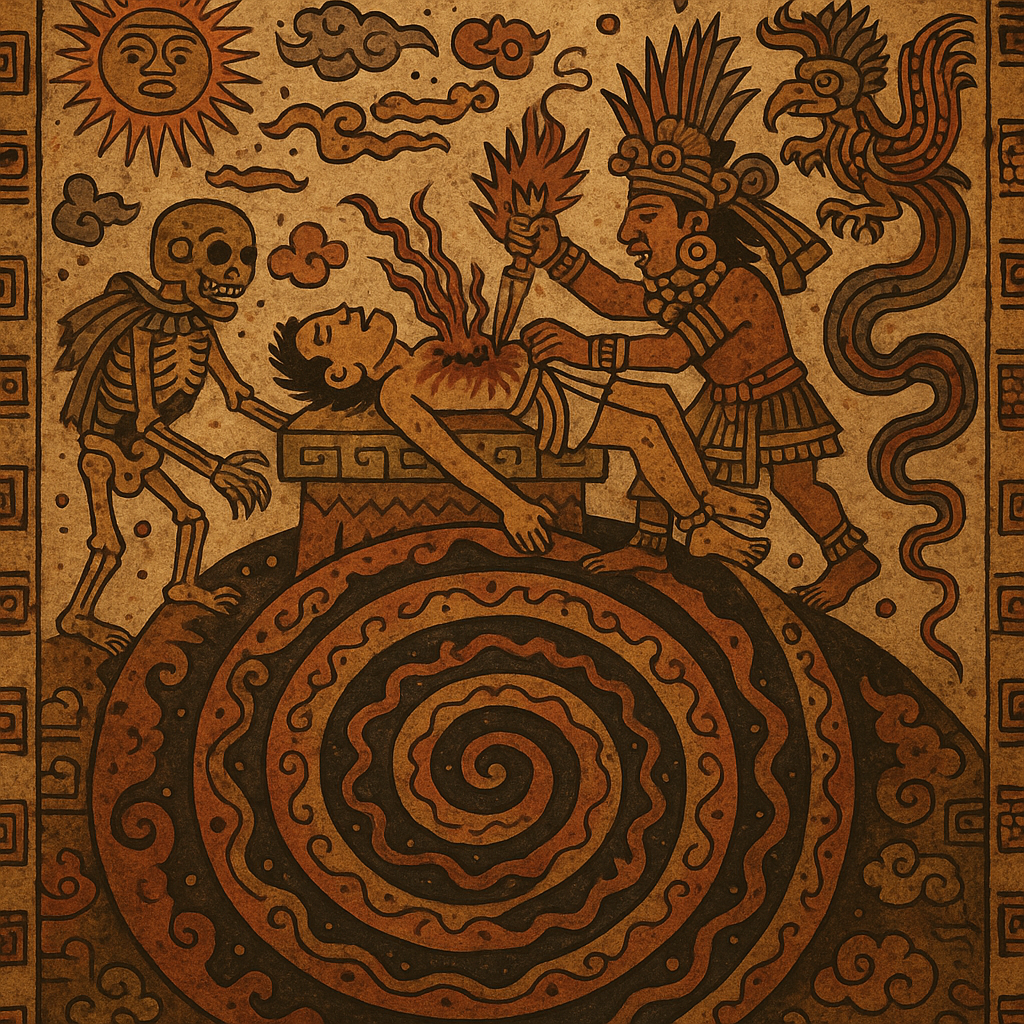
🕰️ Chapter 5: When You Die, the Calendar Remembers
Your death date wasn't an accident. It was a point in the pattern, a moment foretold in the sacred cycles.
The day you were born carried a name and a number, a signature within the Tzolk’in.
The day you died bore one too. Together, they told a story.
And in that story lay the soul’s direction.
If you died in battle, or as a sacrificial offering, you would follow the sun, rising in the east, reborn in light.
If you died by lightning, drowning, or disease, signs of divine touch, you might pass into Tlālocan, a lush paradise ruled by the rain god.
If you died of old age, you would walk the slow spiral down into Mictlán,the nine-fold underworld — not as punishment, but as process.
Your path was not chosen by sin, but by timing.
And so every ritual, every burial, every offering to the dead was calibrated by the calendar — to open the proper portal.
Graves were aligned with solar axes. Jade beads were placed in mouths to guide the breath. Dogs were buried alongside masters — psychopomps for the river crossing.
The date of your death became a password, a key to the correct door in the labyrinth beyond.
Because for the ancient Maya and Aztec, death was not an end. It was an appointment.
And the gods were watching the clock.
⚡ TL;DR:
- The moment of death is encoded within the sacred calendar
- Manner of death determines the soul’s path — not moral judgment
- Sacred dogs guide souls across rivers of the underworld
- Burials include jade, orientation, and offerings for navigation
- To die at the right time is to pass through the correct portal
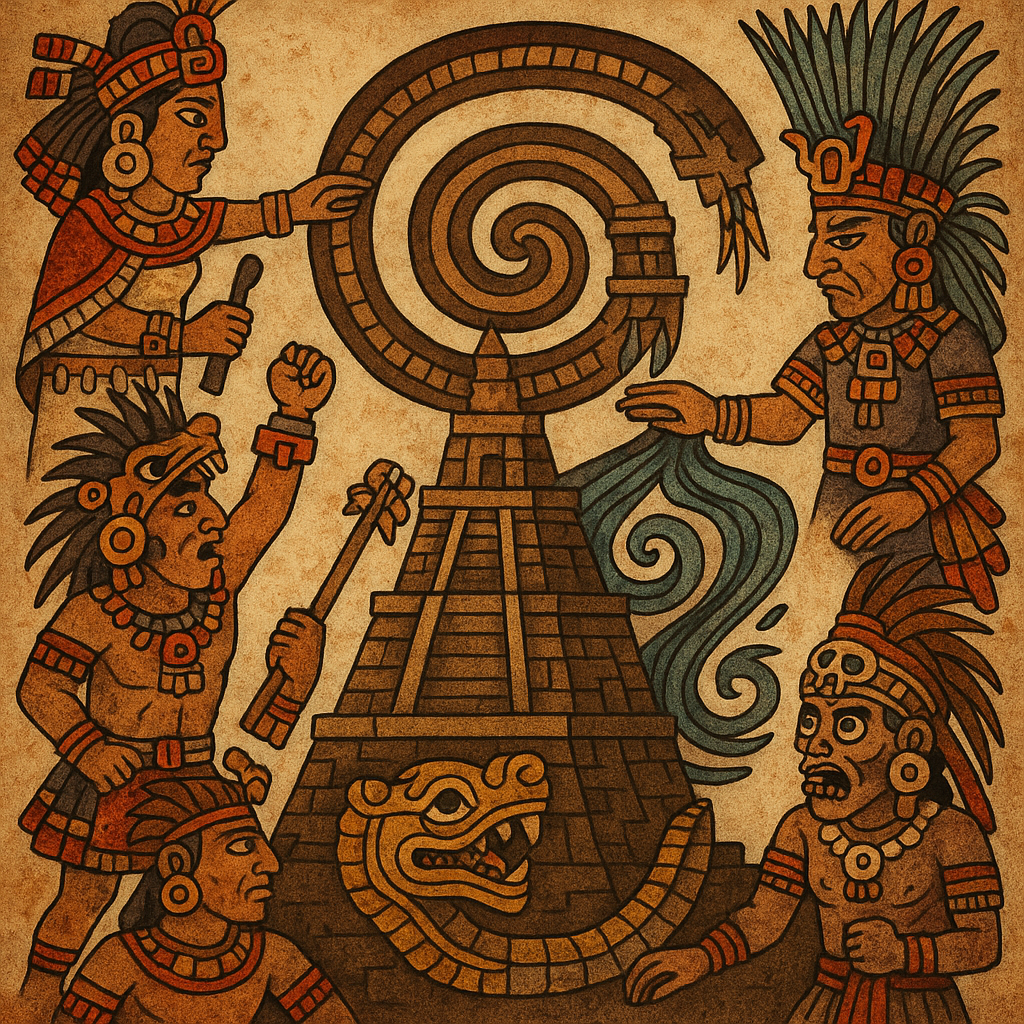
🧠 Quiz: How Well Do You Read the Pyramid?
1. What does the number 52 represent in the Mesoamerican calendar system?
Correct: 52 years marked a full cycle when the Tzolk’in and Haab calendars realigned — a cosmic moment of renewal.
2. What happens at El Castillo during the spring and autumn equinox?
Correct: A serpent-shaped shadow slithers down the northern staircase — an annual alignment of stone, sun, and spirit.
3. In Mesoamerican belief, what determines a person’s afterlife path?
Correct: Afterlife destiny was tied to when and how one died — not morality, but cosmic timing and alignment.
4. What was the purpose of placing jade in the mouth of the deceased?
Correct: Jade symbolised breath, spirit, and soul essence. Placing it in the mouth signified the teyolia’s continuity.
5. What role did dogs play in Mesoamerican funerary rites?
Correct: Dogs were soul-guides (psychopomps), believed to help the dead cross the underworld river toward Mictlán.
📖Glossary
Decode the hidden language of the soul’s exile and return
- Tzolk’in
- 260-day ritual calendar
- Haab
- 365-day solar calendar.
- Calendar Round
- 52-year cycle (Tzolk’in + Haab).
- Tonalli
- Life-force tied to heat, destiny.
- Teyolia
- Heart-based soul essence.
- El Castillo
- Chichén Itzá pyramid and equinox alignment.
- Xochitlalpan
- The Flower World (afterlife realm).
- Directionality
- Sacred four directions + center in ritual space.
- Jade Bead
- Placed in the mouth to symbolise breath and life essence.
🗣️ Discussion Prompt: What Spark Are You Reigniting?
Spread the sacred ripple. Share this scroll and help awaken the memory of cyclical time, soul geometry, and the serpent of return.
💬 Share in the Telegram Temple✨ The Scroll Unfolds
You've seen the pyramid. The shadow serpent. The world etched in time.
Now descend. The calendar opens. The soul leaves the body. Mictlán awaits below.
🔥 Scroll II: The Descent into Mictlán and Xibalba The Rebel Gospel, the Secret Teachings, and the Mirror of the Divine
⚠️ Underworld Interpretation Disclaimer
This scroll journeys through mythic landscapes like Mictlán and Xibalba — vast spiritual realms drawn from Nahua and Maya sources. These depictions are interpretive renderings of cosmological symbolism, not fixed doctrines. Indigenous beliefs were often oral, regionally specific, and deeply ceremonial. What you read here is a spiritual synthesis — a doorway, not a dogma.
Previously: You walked the calendars of stone and remembered the spiral of time. Now descend — into the nine levels of Mictlán and the trial chambers of Xibalba. The Lords are watching. The test is remembering.
🦴 Chapter 6: The Gates Open at Death
“Death was not the end, but a transit. A doorway that required remembrance, offering, and cosmic timing.”
Codex Borgia (paraphrased symbolically)
At the moment of death, the Mesoamerican soul does not drift, it descends.
For the Maya and the Mexica (Aztecs), death initiates a sacred passage. The nature of your death, in battle, childbirth, lightning strike, or illness, determines your soul’s trajectory. Some are taken instantly to paradisiacal realms, like Tlalocan, a lush paradise for those claimed by rain. But most begin a longer journey.
This path begins with a gate.
Not a pearly one, but one marked by obsidian and echoes — a cosmic border where the tonalli (soul heat) begins to cool, and the teyolia (heart-soul) begins to remember.
The first step is not chosen. Death takes your breath, the fire from your blood. What remains must now traverse the map etched in myth — a descent into the layered realms of Mictlán or the perilous trials of Xibalba. Both are underworlds, but not the same. One is Aztec — structured like an inverted pyramid. The other is Maya — a shadowed court of lords, illusions, and deadly games.
In both cases, you are not simply dead.
You are being unmade so that you might be remade.
The underworld does not punish. It strips. It confuses. It mirrors. It devours the ego and waits for the essence.
And before any trial can begin, the soul must pass the watchful gaze of the gods, and face the first question asked in silence:
Did you come prepared?Because the journey is not automatic. The soul must have offerings, jade, maize, incense, or a loyal dog — to pass through. Ritual matters. So does memory. So does kindness.
The gates are open. But not all who die will walk them cleanly.
⚡ TL;DR:
- In Mesoamerican cosmology, death initiates a soul’s descent, not immediate judgement.
- The type of death (battle, childbirth, sickness, lightning) determines the soul’s direction.
- Most souls journey into underworld realms like Mictlán (Aztec) or Xibalba (Maya).
- The soul must carry offerings and memory — jade, incense, maize, or a loyal dog.
- Death is the start of unmaking — a stripping of ego and a test of spiritual essence.
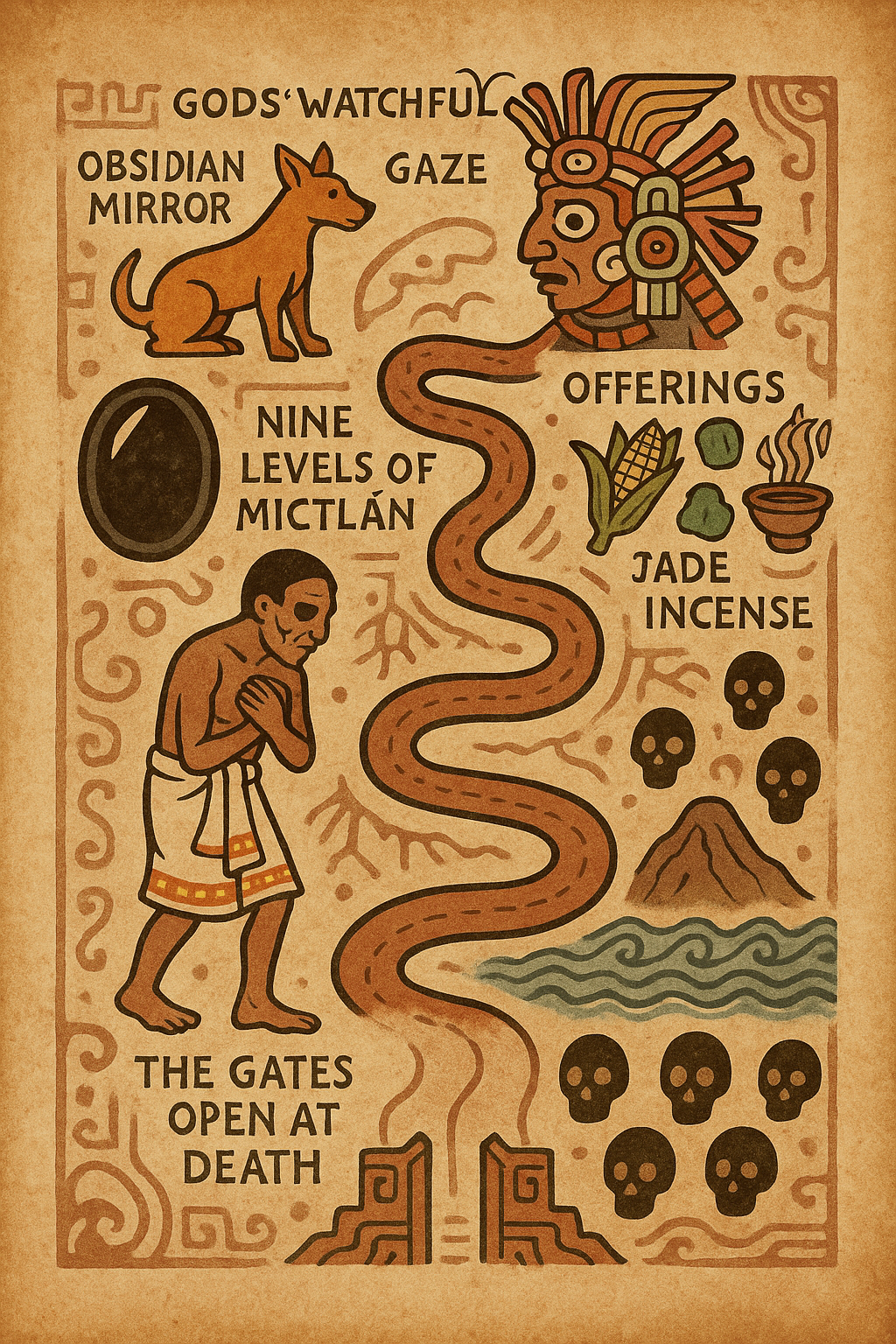
💀 Chapter 7: The Nine Levels of Mictlán
For most of the dead — those not claimed by battle, sacrifice, or lightning — the soul began its descent into Mictlán, the Aztec land of the dead.
It was not hell. It was not heaven.
It was the long, sacred path of dissolution.
This journey, said to take four years, wound through nine underworld levels — each one more symbolic and soul-stripping than the last. These were not punishments. They were ritual processes, sacred disintegrations meant to strip away all that could not return to the Source.
At the first level, the soul faced Apanohuaya, a river that could only be crossed with the help of a dog. Those who had mistreated dogs in life were now left behind — without a guide, without passage.
Then began the trials:
1. Obsidian Winds
Razor gusts that flayed the flesh from the soul — slicing away illusion and attachment.
2. The Spear-Storm
A realm where unseen hands hurled spears — the self pierced by invisible forces.
3. The Crossing of Icy Winds
Breath stolen. Warmth lost. A test of will against the numbing void.
4. The Jaguar Path
A trail guarded by silent jaguars — symbols of fear and spiritual consumption.
5. The Field of Knives
Each step a wound. Every movement a reckoning.
6. The Place of Darkness
No light. No sound. No name. The soul floats unanchored.
7. The Hill of Obsidian
A climb where nothing holds. Each attempt met with collapse.
8. Chicunamictlán — The Place of the Nine
Where the gods of death reign. Where the soul is finally emptied.
Here the journey ended — not in judgement, but in stillness.
All masks gone. All stories dissolved. Nothing remained but essence — that which had survived the blades, mirrors, beasts, and winds.
And that essence, now unburdened, could rise again.
This is the truth at the heart of Mictlán:
The soul must be broken in order to be whole again.
⚡ TL;DR:
- Mictlán is the Aztec underworld — not punishment, but purification through symbolic trials.
- The soul journeys through 9 levels over 4 symbolic years, each stripping away identity and illusion.
- Trials include obsidian winds, jaguar attacks, rivers, collapsing mountains, and fields of knives.
- Only those with offerings (like a loyal dog) can navigate safely, especially in the early levels.
- The journey ends in stillness — the essence survives, freed from form and falsehood.
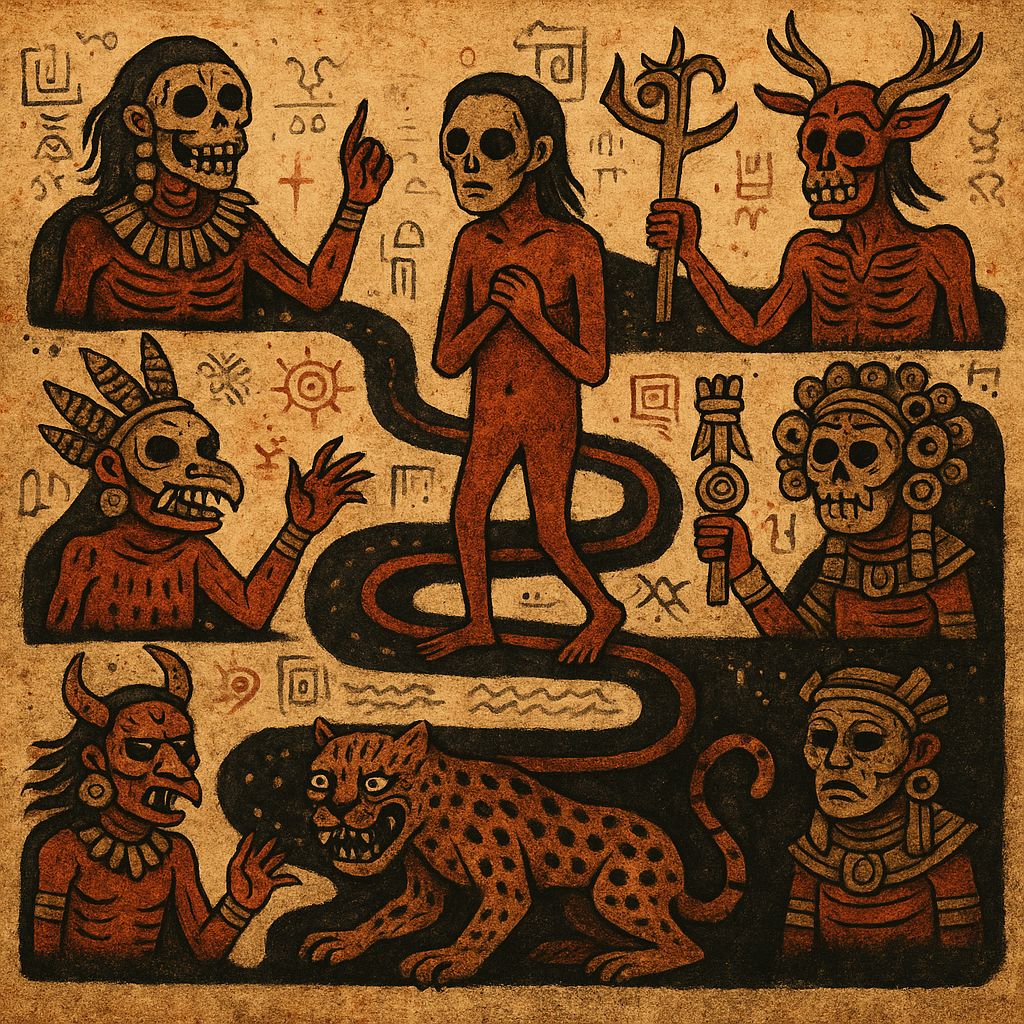
🕷 Chapter 8: The Lords of Xibalba
The Place of Fright, the Game of Death, and the Twins Who Remembered
To the Maya, death was not just a descent — it was a trial of cunning, vision, and inner clarity.
The realm they named Xibalba — “Place of Fright” — was not a punishment ground, but a dark theatre where the soul encountered forces older than form. It was a vast underworld, said to lie in the west, where the sun disappeared each night to face its own rebirth.
Twelve lords ruled this realm. They were not evil, but their nature was decay. Their joy was in misdirection. Their power lay in fear, sickness, filth, and confusion.
Their names spoke their essence:
- One Death
- Seven Death
- Blood Gatherer
- Demon of Bone
- Flying Scab
- Jaundice Demon
- Rotted Mouth
- Skull Scepter
- ...and more.
Each had a domain — a house or chamber — where they tested the soul. These were not places of fire or brimstone. They were trials of perception.
- The Dark House: where no light existed, and the soul’s sense of self vanished.
- The Cold House: where icy winds stripped away false confidence.
- The Jaguar House: where fear prowled in silence.
- The Blade House: lined with moving obsidian.
- The Bat House: death flying in circles.
Into this realm came two heroes — the Hero Twins, Hunahpú and Xbalanqué, sons of a father who had died in this very court.
They entered Xibalba not to escape death, but to defeat it — through cleverness, humility, and endurance.
They failed, died, and then resurrected themselves.
They played tricks on the Lords of Death, and through performance and sacrifice, they reversed the spell of fear.
In the end, they transformed: one into the sun, the other into the moon.
Their story became ritual. Their descent became a blueprint for the soul.
In Maya belief, your death is not your downfall. It is your test. Can you navigate illusion? Can you stay conscious through fright? Can you play the game of death — and remember who you are?
⚡ TL;DR:
- Xibalba is the Maya underworld — a realm of trials ruled by the 12 Lords of Death.
- The soul must pass through symbolic “houses” like darkness, blades, cold, and fear — not for punishment, but for purification.
- The Hero Twins, Hunahpú and Xbalanqué, entered Xibalba to outwit death and restore balance.
- They died and resurrected, proving that consciousness could overcome even the Lords of Decay.
- Their myth became a soul-script: your descent is not your end — it’s your awakening.
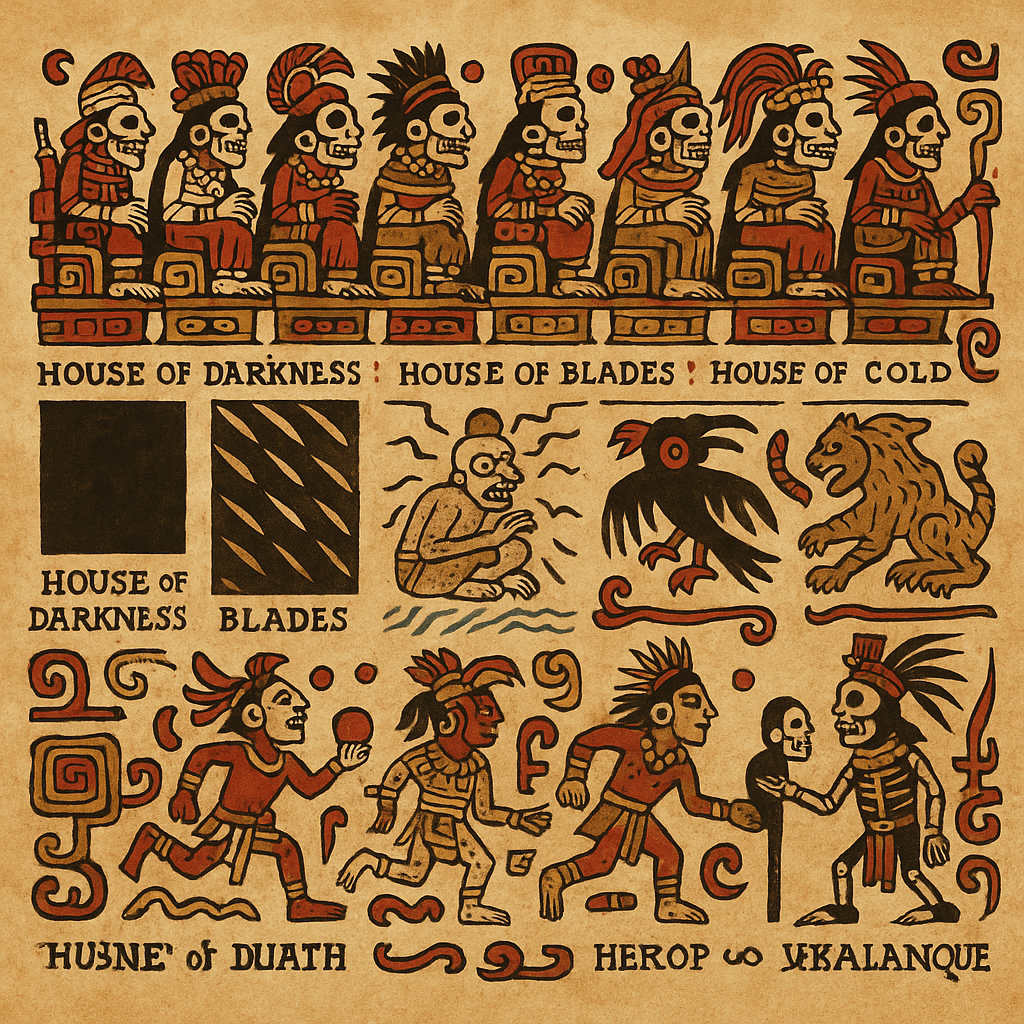
🔪 Chapter 9: Dismemberment and Soul Memory
The Fragmentation of Self and the Return of the Hidden Name
In Mesoamerican belief, the soul did not simply walk through the afterlife — it was taken apart.
To descend into Mictlán or Xibalba was to be dismembered. Not in gore — but in essence.
You lost your name. You lost your face. You lost your memory.
Each level of the underworld stripped something away: warmth, breath, form, direction, certainty.
By the time the soul reached the ninth level, or passed through the last house of trials, it was no longer the person who had died.
And that was the point.
Because what survives is not the personality. Not the mask. Not even the story.
What survives is essence. And with it — if the soul is strong enough — the spark of remembrance.
In Maya cosmology, the bones held memory. Even Quetzalcoatl retrieved the bones of past worlds to recreate humanity. Bones were sacred. Bones were seeds.
Dismemberment was not the end. It was the beginning of reassembly, but only if the soul remembered its pieces.
This is why the soul had to carry offerings — not just for gods, but for itself. Symbols to anchor memory: jade, dog, song, name.
To die was to forget. To pass through the underworld was to relearn who you are, without illusion.
Only then could you return.
⚡ TL;DR:
- In Mesoamerican afterlife, the soul undergoes dismemberment — a stripping of identity, memory, and form.
- This symbolic death dissolves ego and illusion, preparing the essence for return.
- Each level or trial removes another false layer of the self — until only the spark remains.
- Bones were sacred: they held ancestral memory and were used to recreate life (as in the Quetzalcoatl myth).
- The path back requires remembering — piecing yourself together through offerings, symbols, and soul-memory.
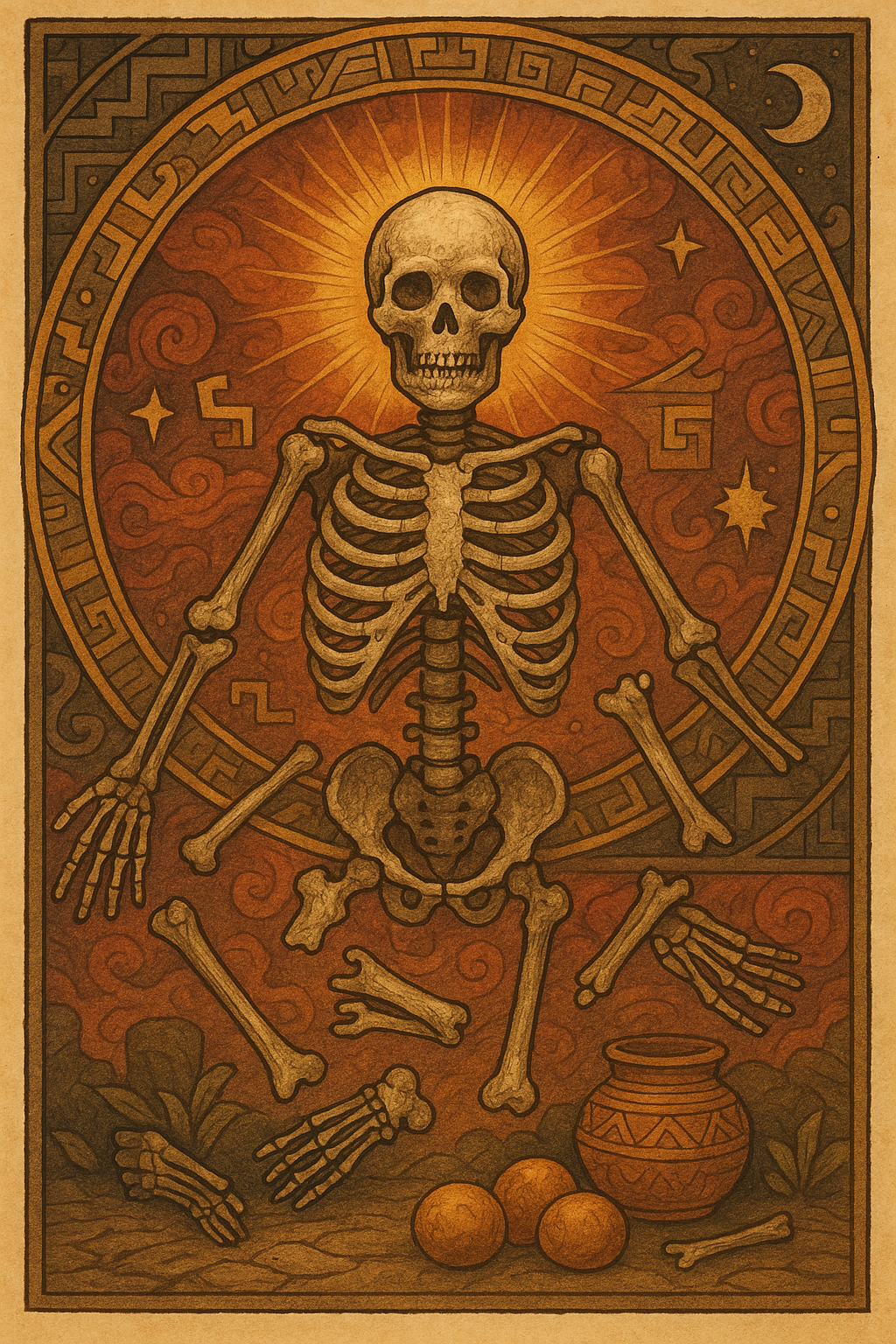
🐕 Chapter 10: The Dog Who Guides You Home
Psychopomp, Loyalty, and the Final Bridge.
When the soul arrives at the first river in Mictlán, dark, wide, and slow-moving, it cannot cross alone.
There is no ferry. No bridge. Only the question: Did you honour the dog?
In Mesoamerican belief, dogs were more than animals. They were psychopomps, soul-guides, sacred companions that could ferry the dead across the waters of the afterlife.
A small yellow or red dog, often named Xoloitzcuintli, would appear at the edge of the underworld river. But it would only help those who had treated dogs with kindness in life.
Those who had abused, mocked, or neglected dogs would be left behind — stranded on the shore.
This was not sentimentalism. It was cosmic reciprocity.
The dog did not judge. It simply remembered.
In some graves, real dogs were buried beside their humans. In others, small dog figurines made of clay or obsidian were placed to symbolise the unseen guide.
The dog’s role was more than physical. It carried memory. It led the soul through confusion, through fear, through forgetting.
Even the Hero Twins, in the Popol Vuh, have a dog companion. Even Quetzalcoatl, though a god. walked beside the dog of death in his descent.
In this cosmology, the most powerful ally in the afterlife was not a priest. Not a spell. But a creature you may have fed or ignored.
And when the soul finally reached the last threshold, having passed wind, blade, beast, and darkness, the dog turned and vanished.
Its work was done. It had delivered you home.
⚡ TL;DR:
- In Mesoamerican cosmology, dogs served as psychopomps — soul-guides for the dead across the underworld river.
- The sacred Xoloitzcuintli dog would only assist those who treated dogs with kindness during life.
- This was not punishment — but a form of spiritual memory and reciprocity.
- Dogs symbolised loyalty, remembrance, and the passage through confusion and fear.
- When the soul reached the final gate, the dog vanished. Its mission complete: you were home.

🧠 Quiz: Have You Broken the Code of the Underworld?
1. What is the purpose of dismemberment in Mesoamerican afterlife cosmology?
Correct: Dismemberment in the underworld removes false identity — it purifies and reveals essence.
2. Who are the Lords of Xibalba in the Popol Vuh?
Correct: The Lords of Xibalba are not evil — they represent decay, illusion, and fear that must be overcome with vision and cunning.
3. What determines whether the dog will help guide your soul across the underworld river?
Correct: In Mesoamerican belief, the Xolo dog remembers your actions — kindness opens the path.
4. Why were bones sacred in Mesoamerican mythology?
Correct: Bones carried ancestral memory — Quetzalcoatl used bones to recreate humanity itself.
5. What was the purpose of the Hero Twins’ descent into Xibalba?
Correct: The Hero Twins descended not to avoid death but to master it — and plant the mythic pattern of rebirth through trial.
📖 The Gnostic Key Glossary — Scroll II Edition
Decode the sacred language of trials, dismemberment, and soul retrieval
- Xibalba
- “Place of Fright” — the Maya underworld ruled by twelve lords of decay, illusion, and trial. A realm of initiation, not punishment.
- Mictlán
- The Aztec land of the dead. A layered underworld navigated by the soul over four years. Dismemberment and memory are central themes.
- Hero Twins
- Mythic Maya figures Hunahpú and Xbalanqué. They descended into Xibalba, faced death, resurrected, and became the sun and moon.
- Xoloitzcuintli
- The sacred hairless dog that guides souls across the underworld river. Only assists those who showed kindness in life.
- Obsidian
- Volcanic glass used in ritual and warfare. Symbol of vision, sacrifice, and the cutting away of illusion.
- Bone Memory
- The belief that bones hold ancestral and cosmic memory. Dismemberment allows truth to be reassembled.
- Underworld Houses
- Trial chambers like the Dark House, Jaguar House, and Bat House — each symbolising a test of soul awareness and courage.
- Psychopomp
- A guide of souls after death. In Mesoamerica, this was often a dog — a being that remembered your truth when you forgot.
🗣️ Discussion Prompt: What Did You Face in the House of Fear?
“In the darkness of Xibalba, what mask did you lose? And what part of you refused to die?”
This scroll was not a story — it was an invitation. A descent into your own forgotten trials. A map made of myth and marrow.
- Which of the Houses — Dark, Jaguar, Bat — reflected something inside you?
- Did you recognise any Lords of Xibalba in your waking life?
- What illusions died in you during this reading?
- Would your Xolo guide you — or turn away?
Leave the echo. Pass the riddle on. Post with #TheGnosticKey or enter the Telegram Temple.
🪜 Continue the Journey
You have descended. Faced the Lords. Walked through houses of fear, cold, and confusion. You remembered something the system tried to erase.
But the descent was only part of the spiral.
Now comes the resurrection — the ascent back through sacrifice, memory, and time. Scroll III reveals the sacred code of return, the cosmic rebirth, and the serpent that swallows the years.
🌀 Scroll III: The Spiral of Return Time resets, the serpent coils, and the soul remembers what it always was.
⚠️ Gnostic Diversity Disclaimer
The afterlife map in this scroll draws from texts like the Apocalypse of Paul, Apocryphon of John, and Pistis Sophia — each detailing soul ascent, toll gates, and Archonic interrogation. These reflect a Sethian cosmology of resistance and remembrance. Other Gnostic streams, such as the Valentinian, offered more harmonised visions of divine reunion. What you read here is a path — not the only one — through the Gnostic sky.
Previously: You descended into Mictlán, outwitted the Lords of Xibalba, and faced the games of death. Now begins the spiral upward — through sacrifice, memory, and the soul’s return to the celestial maize field.
🌀 Chapter 11: The 52-Year Renewal
The Calendar Round, the Fire Ceremony, and the Reset of Worlds.
“Each cycle closes in flame. Not to destroy, but to relight the path.”
For the peoples of Mesoamerica, time was not a straight line, it was a spiral. A sacred return. And every 52 years, that spiral completed a full turn.
This was known as the Calendar Round, the moment when the 260-day sacred calendar (Tzolk’in) and the 365-day solar calendar (Haab) realigned. It was not simply an astronomical event, it was the spiritual re-synchronisation of the world with the gods.
But it was also terrifying.
Because if the gods did not relight the flame at the end of the 52-year cycle, the world would end.
On the final night of the cycle, every fire across the empire was extinguished. Families sat in darkness, fasting and praying. Priests climbed to sacred mountaintops to perform the New Fire Ceremony, piercing the chest of a sacrificial victim to ignite a new flame in their body.
If the stars moved as expected, and the fire caught, the world was reborn.
The new flame was carried like divine lightning to every home. Life restarted. Time had survived itself.
But it was more than survival. It was symbolic resurrection. A reminder that death and return were woven into the very structure of time.
⚡ TL;DR:
- The Calendar Round (52 years) is a sacred cycle when the solar and sacred calendars realign
- At the end of each cycle, all fires were extinguished to await cosmic renewal
- The New Fire Ceremony reignited the divine flame through ritual sacrifice
- This ritual ensured the world’s continuation — a rebirth encoded in time
- In Gnostic terms, it mirrors the soul’s spiral path back to Source through ritual remembering
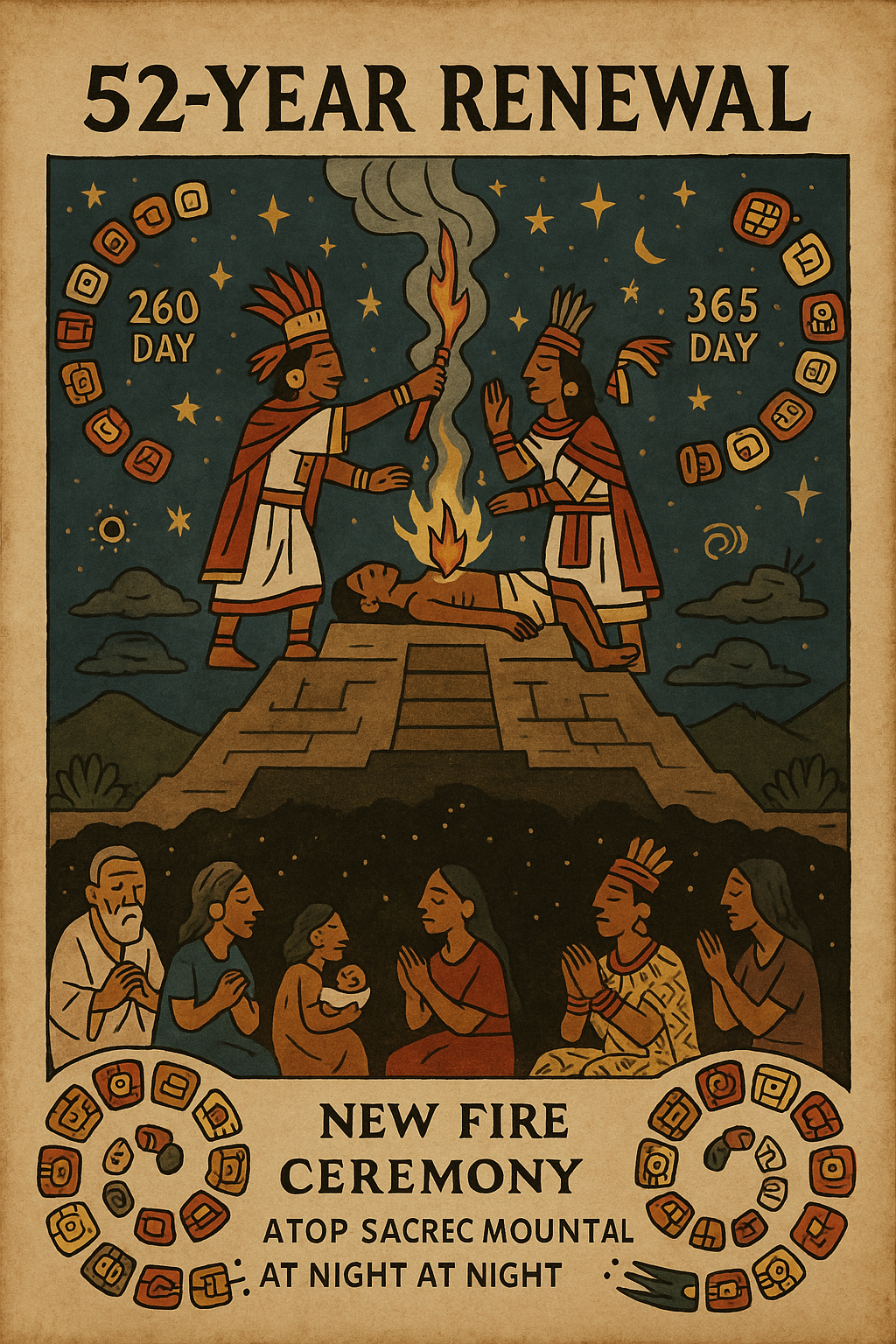
🐍 Chapter 12: Serpent of Cycles
Quetzalcoatl, Time, and the Spiral of Return.
“Time does not march forward. It coils. It remembers.”
In Mesoamerican cosmology, time moved in spirals, not straight lines. It was the breath of the cosmos, coiling and returning. And the being who embodied that sacred motion was the serpent.
The serpent was not evil. It was sacred. It slithered between the realms, heaven, earth, and the underworld, shedding its skin, renewing itself, always returning.
Its greatest form was Quetzalcoatl, the Feathered Serpent, god of wind, breath, wisdom, and resurrection. But more than a deity, he was a mythic code.
He descended into the underworld to gather the bones of past worlds. But he stumbled. The bones broke. He bled upon them to bring humanity back into being.
This story is not linear, it’s spiral revelation:
- Descent into forgetting
- Fragmentation
- Sacrifice
- Return
Quetzalcoatl is the soul’s journey, the one who dies and rises again, not once, but each time the world forgets.
Each spring equinox, his shadow-serpent slithers down the pyramid at Chichén Itzá. Not as a prophecy fulfilled, but as a pattern remembered.
He is not a saviour. He is a mirror of the path.
⚡ TL;DR:
- Time in Mesoamerica is cyclical — a spiral of descent, sacrifice, and return
- The serpent represents renewal, not evil — it sheds, moves, transforms
- Quetzalcoatl (Feathered Serpent) is a god of wind, wisdom, and resurrection
- He descended to the underworld, broke the bones of humanity, and bled life back into them
- His descent and rise reflect the soul’s Gnostic path: fall, forget, remember, return
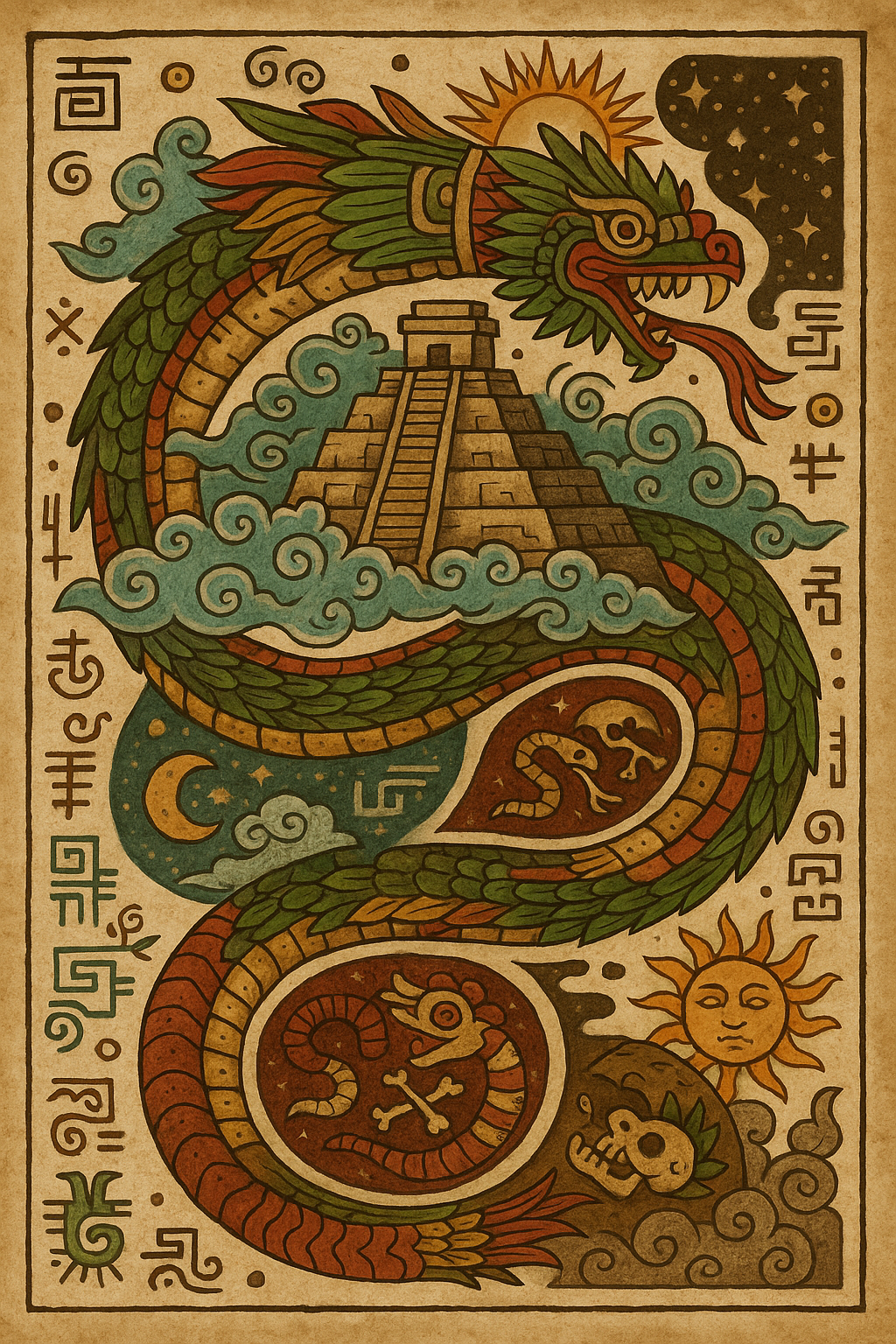
💀 Chapter 13: Rebuilding the Bones
Remembrance, Resurrection, and the Soul’s Reassembly.
“From fragments, we are made again.”
In the beginning, we were broken. Not as punishment, but as potential. Because from fragments, new forms arise. And in the Mesoamerican mythos, it is bones that remember.
After Quetzalcoatl retrieved the bones of past humanity from the underworld, they shattered in his fall. But he did not abandon them. He bled upon them. He gave of himself. And in that blood-bone fusion, we were reborn.
This is not merely myth. It is a map of the soul’s re-creation.
To journey through the afterlife is to be taken apart, stripped by wind, shadow, silence, and blade. But if the spark endures… if memory survives the forgetting… the soul can reassemble itself. Piece by sacred piece.
This is the deeper function of ritual objects:
- Jade in the mouth
- Dog at your feet
- Direction of burial
They are not magic charms. They are anchors for memory. Fragments of the self waiting to be recovered.
In this scroll, you've died. You've descended. You've forgotten.
Now, you remember. And in remembrance, the bones knit again. Not as they were, but as they were meant to become.
⚡ TL;DR:
- Quetzalcoatl retrieved the bones of humanity from the underworld, but they shattered in the process
- He bled upon the bones, mixing sacrifice and memory to bring life anew
- In Mesoamerican myth, bones hold the memory of the soul’s origin
- Ritual burial items like jade, dogs, and orientation were anchors for remembrance
- The soul must reassemble itself after death — not as it was, but as it was meant to become
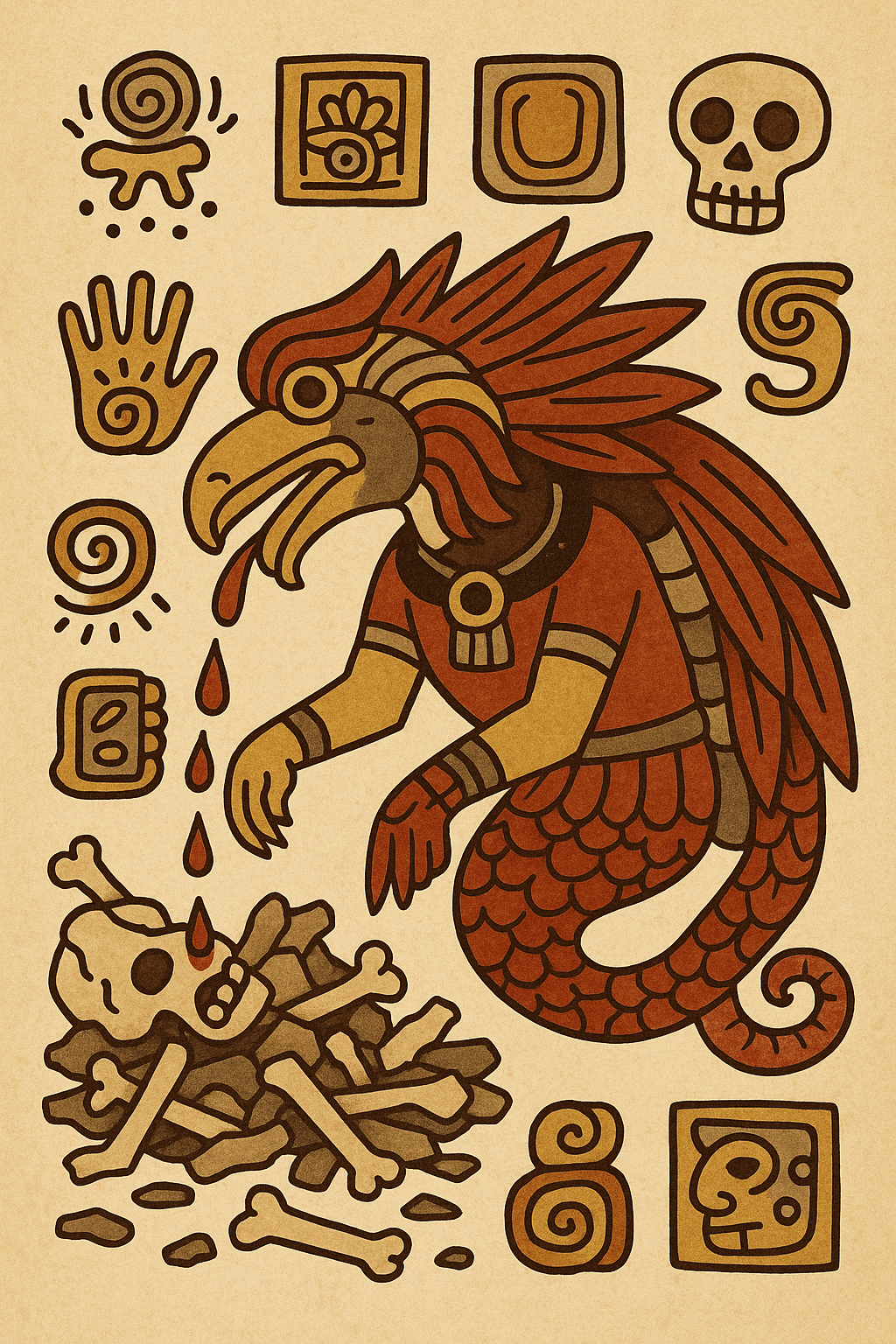
🔢 Chapter 14: The Soul as Calendar
Glyphs, Destiny, and the Divine Geometry of You.>
To the ancients of Mesoamerica, you were not born on a blank day.
You were born into a glyph, a combination of sacred number, elemental sign, and cosmological rhythm. That glyph was your essence. Your vibration. Your shape in the cosmic flow.
The sacred calendar, Tzolk’in, held 260 days. Each day carried a unique energy pairing — one of 13 numbers, one of 20 glyphs. Combined, they formed a map of destiny, and a signature of soul.
Priests did not just chart days, they read the soul’s pattern.
And when you died, your soul returned to this divine geometry. The calendar remembered you, even when you had forgotten yourself.
This is why bodies were buried with their birth glyphs, why bones were aligned with directional forces, and why jade, symbol of breath and soul essence, was placed in the mouth.
To restore the pattern. To remind the soul of who it truly was.
In Gnostic terms, the calendar is the cosmic DNA, a divine code that the Archons have tried to suppress with artificial time, mechanical clocks, and Gregorian forgetting.
But beneath all that, your glyph still burns.
You are not random. You are a pattern unfolding. You are a calendar of light.
⚡ TL;DR:
- Tzolk’in is the sacred 260-day calendar used to determine soul patterns and life destiny.
- Each person is born under a unique glyph and number, forming a spiritual signature.
- The soul returns to this cosmic pattern at death — it is a memory map.
- Jade placed in the mouth symbolised breath and essence, guiding the soul back to its true identity.
- Modern time systems are artificial overlays — your true glyph still pulses beneath them.
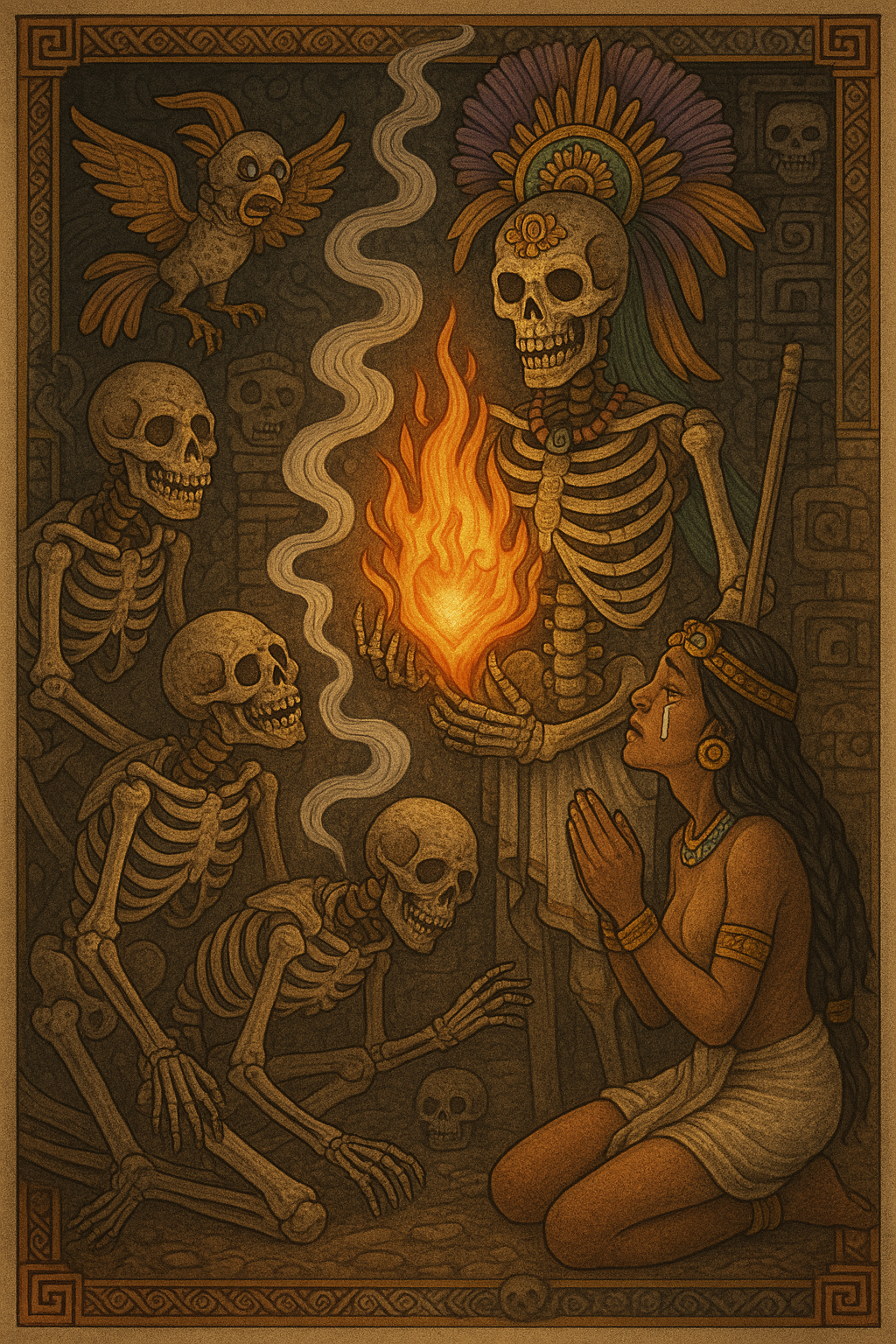
🕊 Chapter 5: Return of the Feathered Spark
Resurrection, Light-Body, and the Path Beyond the Cycle.
At the end of the spiral, the soul does not vanish. It transforms.
The trials are not the point. The offerings are not the point. Even the calendar is not the point.
They were mirrors, tools to remember the divine spark buried beneath bone, breath, and forgetting.
When the spark is remembered, the cycle no longer binds. You do not return to Mictlán. You do not realign the calendar.
You rise.
In Aztec belief, those who achieved full resonance, through death in childbirth, war, or ritual offering, became butterflies or hummingbirds, radiant beings who travelled with the sun. Others merged into the Flower World, a realm of fragrance, beauty, and light-body consciousness.
This was not heaven. It was the soul in bloom, a being who no longer spirals, but expands.
In Maya cosmology, the Hero Twins became the sun and moon. Not because they escaped death, but because they remembered themselves through it.
Quetzalcoatl, too, did not die once. He returned. Again. And again. In times of forgetting. In ages of darkness.
Because he was the pattern, not a saviour, but a resonance. And when the soul rises through remembrance, the Feathered Spark returns through you.
⚡ TL;DR:
- The ultimate goal of the Mesoamerican afterlife is not return, but transformation
- The “Feathered Spark” is a symbol of spiritual resurrection — a soul awakened
- Beings who complete the journey may enter the Flower World, a state of divine beauty and consciousness
- Quetzalcoatl, the Feathered Serpent, is a returning pattern — a symbol of rebirth through remembrance
- When the soul remembers itself through death, it becomes radiant and unbound by cycles
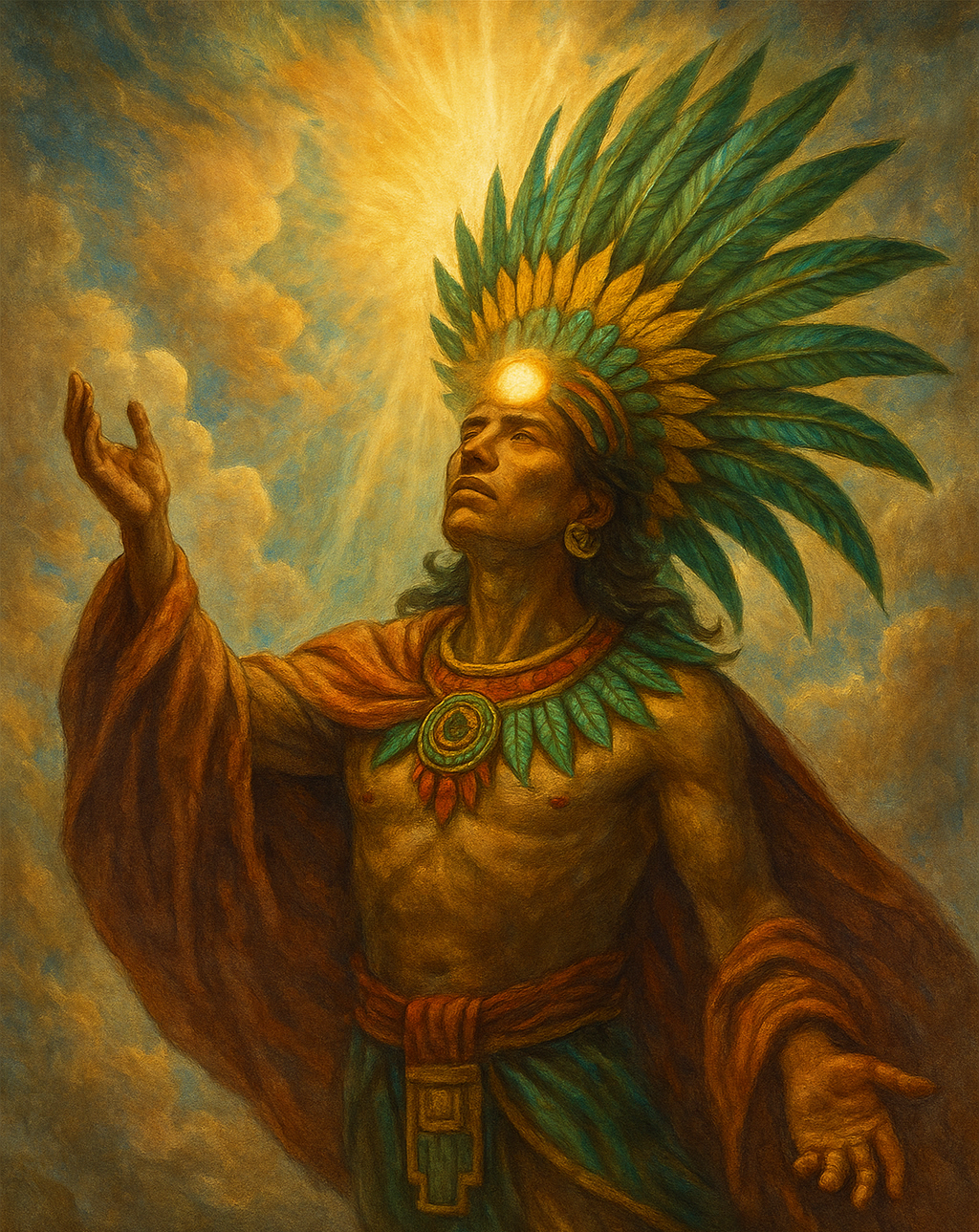
🧠 Quiz: Have You Remembered the Spiral?
1. What is the Calendar Round in Mesoamerican cosmology?
Correct: The Calendar Round marks the sacred alignment of the Tzolk’in and Haab calendars every 52 years — a time of cosmic reset.
2. What does Quetzalcoatl’s journey through death symbolise?
Correct: His descent and bleeding on the bones represents the cosmic spiral — fall, fragmentation, and resurrection through memory.
3. What happens when a soul fully remembers itself?
Correct: The awakened soul transcends the cycle and becomes a radiant being — often imagined as butterfly, hummingbird, or solar companion.
4. What is the spiritual function of jade in Mesoamerican funerary rites?
Correct: Jade symbolised breath and spiritual essence — placed in the mouth to guide the soul’s return through remembrance.
5. What is the “Feathered Spark”?
Correct: The Feathered Spark is the soul in full remembrance — the one who returns, not through fate, but through light.
📖 The Gnostic Key Glossary — Scroll III Edition
Terms of remembrance, resurrection, and spiral return
- Calendar Round
- A sacred 52-year cycle when the Tzolk’in (260-day ritual calendar) and Haab (365-day solar calendar) realign — a time of reset, ritual, and cosmic re-ordering.
- Quetzalcoatl
- The Feathered Serpent deity who embodies resurrection, wind, and sacred time. His descent and return mirror the soul’s journey through forgetting and rebirth.
- Tzolk’in
- The 260-day sacred Mesoamerican calendar used to determine birth glyphs, soul destiny, and spiritual resonance. Each day carries unique energy and symbolism.
- Feathered Spark
- The awakened soul after remembrance — radiant, unbound, and no longer ruled by the wheel. Symbol of return beyond cycles.
- Flower World
- A paradisiacal realm of spiritual flowering in Mesoamerican cosmology. The final return of those who passed all trials and remembered their true form.
- New Fire Ceremony
- A ritual performed at the end of each 52-year cycle to reignite divine order. Symbol of death and re-ignition, linking sacrifice with cosmic rebirth.
- Light-Body
- The resurrected form of the soul — not flesh, but radiance. What emerges when all false layers are shed and remembrance is complete.
🎨 Creative Prompt: Voice of the Bones
Write from the voice of your soul descending through Mictlān — the land of shadows, trials, and silence. Title your piece “Voice of the Bones.”
- What part of you must be shed to pass through each level?
- Which Lord of Death stares at you without blinking?
- What sacred memory do you carry, buried in your marrow?
- What dream returns to you on the ninth night?
Want to share your descent?
🗣️ Discussion Prompt: What Did You Leave in the Underworld?
“If your bones could speak, what would they confess before they turn to stars?”
This scroll wasn’t a story. It was a descent. A rite. A remembering of the path walked by every soul.
You will pass through nine layers. You will lose your name. And only the essence will rise.
- Which of the Nine Houses do you fear the most, and why?
- What part of your false self must die to cross the obsidian river?
- Have you met your soul’s twin — the one who walks beside you unseen?
- Do you believe death is the end, or the final test of memory?
📚 Sacred Timekeepers & Mythic Sources
The teachings in this scroll are drawn from preserved glyphs, oral memory, and the bones of burned libraries. These sources echo the rhythm of a people who saw time spiral, not end.
🔍 Suggested Study
- Popol Vuh — The sacred K’iche’ Maya text, recounting the Hero Twins and Xibalba
- Codex Borgia — Central Mexican ritual codex full of symbolic death journeys
- Time and the Highland Maya by Barbara Tedlock — Insights on Maya calendrics and soul belief
- The Myth of the Eternal Return by Mircea Eliade — A wider look at cyclical time and sacred myth
📖 Archaeological & Scholarly Anchors
- Christenson, A. (2007). Popol Vuh: The Sacred Book of the Maya. University of Oklahoma Press.
- Taube, K. (1993). Aztec and Maya Myths. British Museum Press.
- Tedlock, B. (1992). Time and the Highland Maya. University of New Mexico Press.
🌌 Continue the Journey
You've walked the spiral. Faced the Lords of Xibalba. Resurrected through myth, blood, and memory.
This was not the end. It was training.
Every tradition hides a fragment of the escape code. The Gnostic Key’s Afterlife Series maps them all.
Explore the next gates:
- Gnostic Christianity, Christ the Revealer and the Map of Return
- Sufi Islam, Barzakh, the Beloved, and the Spiral Path
- Jewish Kabbalah, Ascent Through the Sefirot and the Breath of Binah
- Buddhist Afterlife, Karma, Bardo, and the Diamond Path
- Ancient Egypt, The Akh, the Scales, and the Star Map
- Mesoamerica, Xibalba, the Hero Twins, and the Spiral of Sacrifice